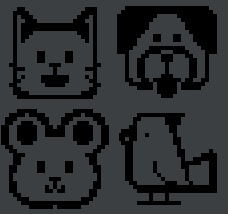Deep Learning and Eclipse Collections
Published: 2022-10-11 10:41AM
In previous blogs, we’ve covered Eclipse Collections and Deep Learning. Recently, a couple of the highly recommended katas for Eclipse Collections have been revamped to include "pet" and "fruit" emojis for a bit of extra fun. What could be better than Learning Eclipse Collections?Deep Learning and Eclipse Collections of course!
Setting up our model and data
First, we create a PetType enum with the emoji as toString:
enum PetType {
CAT("🐱"),
DOG("🐶"),
HAMSTER("🐹"),
TURTLE("🐢"),
BIRD("🐦"),
SNAKE("🐍")
private final String emoji
PetType(String emoji) { this.emoji = emoji }
@Override
String toString() { emoji }
}Then a Pet record (with the type as the toString):
record Pet(PetType type, String name, int age) {
String toString() { type.toString() }
}Similarly, we’ll create a Person record. We’ll also populate a people list as is done in the kata. The full details are in the repo.
Let’s use a GQuery expression to explore the pre-populated list:
println GQ {
from p in people
select p.fullName, p.pets
}The result is:
+---------------+----------+
| fullName | pets |
+---------------+----------+
| Mary Smith | [🐱] |
| Bob Smith | [🐱, 🐶] |
| Ted Smith | [🐶] |
| Jake Snake | [🐍] |
| Barry Bird | [🐦] |
| Terry Turtle | [🐢] |
| Harry Hamster | [🐹, 🐹] |
| John Doe | [] |
+---------------+----------+Now let’s duplicate the assertion from the getCountsByPetType test in the original kata’s exercise3 which checks pet counts:
var counts = people.countByEach(person -> person.petTypes).collect(Object::toString)
var expected = Bags.mutable.withOccurrences("🐱", 2, "🐶", 2, "🐹", 2).with("🐍").with("🐢").with("🐦")
assert counts == expectedAs we expect, it passes.
Applying deep learning
Now, for a bit of fun, we will use a neural network trained to detect cat and dog images and apply it to our emojis. We’ll follow the process described here. It uses Eclipse DeepLearning4j to train and then use a model. The images used to train the model were real cat and dog images, not emojis, so we aren’t expecting our model to be super accurate.
The first attempt was to write the emojis into swing JLabel components and then save using a buffered image. This lead to poor looking images:

And consequently, poor image inference. Recent JDK versions on some platforms might do better, but we gave up on this approach.
Instead, emoji image files from the Noto Color Emoji font were used and saved under the pet type in the resources folder. These look much nicer:

Here is the code which makes use of those saved images to detect the animal types (note the use of type aliasing since we have two PetType classes; we rename one to PT):
import ramo.klevis.ml.vg16.PetType as PT
import ramo.klevis.ml.vg16.VG16ForCat
var vg16ForCat = new VG16ForCat().tap{ loadModel() }
var results = []
people.each{ p ->
results << p.pets.collect { pet ->
var file = new File("resources/${pet.type.name()}.png")
PT petType = vg16ForCat.detectCat(file, 0.675d)
var desc = switch(petType) {
case PT.CAT -> 'is a cat'
case PT.DOG -> 'is a dog'
default -> 'is unknown'
}
"$pet.name $desc"
}
}
println results.flatten().join('\n')Note that the model exceeds the maximum allowable size for normal GitHub repos, so you should create it following the original repo instructions and then store the resulting model.zip in the resources folder.
When we run the script, we get the following output:
[main] INFO org.nd4j.linalg.factory.Nd4jBackend - Loaded [CpuBackend] backend
...
[main] INFO org.nd4j.linalg.api.ops.executioner.DefaultOpExecutioner - Blas vendor: [OPENBLAS]
...
==========================================================================================
VertexName (VertexType) nIn,nOut TotalParams ParamsShape Vertex Inputs
==========================================================================================
input_1 (InputVertex) -,- - - -
block1_conv1 (Frozen ConvolutionLayer) 3,64 1792 b:{1,64}, W:{64,3,3,3} [input_1]
block1_conv2 (Frozen ConvolutionLayer) 64,64 36928 b:{1,64}, W:{64,64,3,3} [block1_conv1]
block1_pool (Frozen SubsamplingLayer) -,- 0 - [block1_conv2]
block2_conv1 (Frozen ConvolutionLayer) 64,128 73856 b:{1,128}, W:{128,64,3,3} [block1_pool]
block2_conv2 (Frozen ConvolutionLayer) 128,128 147584 b:{1,128}, W:{128,128,3,3} [block2_conv1]
block2_pool (Frozen SubsamplingLayer) -,- 0 - [block2_conv2]
block3_conv1 (Frozen ConvolutionLayer) 128,256 295168 b:{1,256}, W:{256,128,3,3} [block2_pool]
block3_conv2 (Frozen ConvolutionLayer) 256,256 590080 b:{1,256}, W:{256,256,3,3} [block3_conv1]
block3_conv3 (Frozen ConvolutionLayer) 256,256 590080 b:{1,256}, W:{256,256,3,3} [block3_conv2]
block3_pool (Frozen SubsamplingLayer) -,- 0 - [block3_conv3]
block4_conv1 (Frozen ConvolutionLayer) 256,512 1180160 b:{1,512}, W:{512,256,3,3} [block3_pool]
block4_conv2 (Frozen ConvolutionLayer) 512,512 2359808 b:{1,512}, W:{512,512,3,3} [block4_conv1]
block4_conv3 (Frozen ConvolutionLayer) 512,512 2359808 b:{1,512}, W:{512,512,3,3} [block4_conv2]
block4_pool (Frozen SubsamplingLayer) -,- 0 - [block4_conv3]
block5_conv1 (Frozen ConvolutionLayer) 512,512 2359808 b:{1,512}, W:{512,512,3,3} [block4_pool]
block5_conv2 (Frozen ConvolutionLayer) 512,512 2359808 b:{1,512}, W:{512,512,3,3} [block5_conv1]
block5_conv3 (Frozen ConvolutionLayer) 512,512 2359808 b:{1,512}, W:{512,512,3,3} [block5_conv2]
block5_pool (Frozen SubsamplingLayer) -,- 0 - [block5_conv3]
flatten (PreprocessorVertex) -,- - - [block5_pool]
fc1 (Frozen DenseLayer) 25088,4096 102764544 b:{1,4096}, W:{25088,4096} [flatten]
fc2 (Frozen DenseLayer) 4096,4096 16781312 b:{1,4096}, W:{4096,4096} [fc1]
predictions (OutputLayer) 4096,2 8194 b:{1,2}, W:{4096,2} [fc2]
------------------------------------------------------------------------------------------
Total Parameters: 134268738
Trainable Parameters: 8194
Frozen Parameters: 134260544
==========================================================================================
...
Tabby is a cat
Dolly is a cat
Spot is a dog
Spike is a dog
Serpy is a cat
Tweety is unknown
Speedy is a dog
Fuzzy is unknown
Wuzzy is unknown
As we can see, it correctly predicted the cats (Tabby and Dolly) and dogs (Spot and Spike) but incorrectly thought a snake (Serpy) was a cat and a turtle (Speedy) was a dog. Given the lack of detail in the emoji images compared to the training images, this lack of accuracy isn’t unexpected. We could certainly use better images or train our model differently if we wanted better results, but it is fun to see our model not doing too badly even with emojis!
